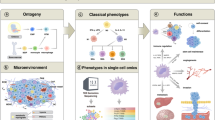Abstract
Macrophages represent not only the first line of defense against pathogens and are the main drivers of inflammation but are also involved in the initiation, immune evasion as well as metastasis of tumors. Therefore, it has been suggested that diminishing the immune regulatory function of macrophages would support the natural immune surveillance or antitumor therapies, respectively. However, the plasticity of macrophages represents an obstacle in understanding and manipulating the role of macrophages in tumor tissue or the tumor microenvironment. Here, we describe a protocol to differentiate macrophages, based on changing their metabolic environment, from bone marrow precursors to tumor-associated macrophage-like cells of an immune suppressive phenotype. Based on these protocols, the inhibitory functional phenotype of macrophages can be manipulated and therefore further analyzed as described, by interrupting metabolic pathways.
Access this chapter
Tax calculation will be finalised at checkout
Purchases are for personal use only
Similar content being viewed by others
References
Bronte V (2014) Tumor cells hijack macrophages via lactic acid. Immunol Cell Biol 92:647
Wu H, Han Y, Sillke YR, Deng H, Siddiqui S, Treese C, Schmidt F, Friedrich M, Keye J, Wan J (2019) Lipid droplet-dependent fatty acid metabolism controls the immune suppressive phenotype of tumor-associated macrophages. EMBO Mol Med 11
Mantovani A, Sozzani S, Locati M, Allavena P, Sica A (2002) Macrophage polarization: tumor-associated macrophages as a paradigm for polarized M2 mononuclear phagocytes. Trends Immunol 23:549–555
Noy R, Pollard JWJI (2014) Tumor-associated macrophages: from mechanisms to therapy. Immunity 41:49–61
Hossain F, Al-Khami AA, Wyczechowska D, Hernandez C, Zheng L, Reiss K, Del Valle L, Trillo-Tinoco J, Maj T, Zou WJC i r (2015) Inhibition of fatty acid oxidation modulates immunosuppressive functions of myeloid-derived suppressor cells and enhances cancer therapies. J Immunother Cancer 3:1236–1247
Mills EL, O’Neill LA (2016) Reprogramming mitochondrial metabolism in macrophages as an anti-inflammatory signal. Eur J Immunol 46:13–21
Wu H, Weidinger C, Schmidt F, Keye J, Friedrich M, Yerinde C, Willimsky G, Qin Z, Siegmund B, Glauben RJS r (2017) Oleate but not stearate induces the regulatory phenotype of myeloid suppressor. Cell 7:1–14
Medzhitov R (2008) Origin and physiological roles of inflammation. Nature 454:428–435
Etzerodt A, Moulin M, Doktor TK, Delfini M, Mossadegh-Keller N, Bajenoff M, Sieweke MH, Moestrup SK, Auphan-Anezin N, Lawrence T (2020) Tissue-resident macrophages in omentum promote metastatic spread of ovarian cancer. J Exp Med 217
Linde N, Casanova-Acebes M, Sosa MS, Mortha A, Rahman A, Farias E, Harper K, Tardio E, Reyes Torres I, Jones J, Condeelis J, Merad M, Aguirre-Ghiso JA (2018) Macrophages orchestrate breast cancer early dissemination and metastasis. Nat Commun 9:21
Wenes M, Shang M, Di Matteo M, Goveia J, Martin-Perez R, Serneels J, Prenen H, Ghesquiere B, Carmeliet P, Mazzone M (2016) Macrophage metabolism controls tumor blood vessel morphogenesis and metastasis. Cell Metab 24:701–715
Acknowledgments
This work was supported by the Deutsche Krebshilfe (70112011) as well as the China Scholarship Council and the “Fellowship for Young International Scientists”-program of the Chinese Academy of Science.
Author information
Authors and Affiliations
Corresponding author
Editor information
Editors and Affiliations
Rights and permissions
Copyright information
© 2021 Springer Science+Business Media, LLC, part of Springer Nature
About this protocol
Cite this protocol
Wu, H., Glauben, R. (2021). Fatty Acid–Driven Polarization of Suppressive Bone Marrow–Derived Macrophages Including Metabolic and Functional Analysis. In: Stein, U.S. (eds) Metastasis. Methods in Molecular Biology, vol 2294. Humana, New York, NY. https://doi.org/10.1007/978-1-0716-1350-4_14
Download citation
DOI: https://doi.org/10.1007/978-1-0716-1350-4_14
Published:
Publisher Name: Humana, New York, NY
Print ISBN: 978-1-0716-1349-8
Online ISBN: 978-1-0716-1350-4
eBook Packages: Springer Protocols




